Early ripening potato variety “Zorachka” for fresh consumption
The early ripening potato variety Zorachka is the result of the work of Belarusian scientists. It has gained popularity among beginners and professional farmers who love the variety for its taste and short growing season. Let's talk about it in more detail today.
Description of the variety
What are Zorachka potatoes?
This is an early ripening table variety. The period from planting to harvest takes an average of 70 days, but the first digging is done already on the 45th day. The bushes form erect, powerful shoots of low or medium height (no more than 60 cm), with medium-sized leaves and light blue flowers.
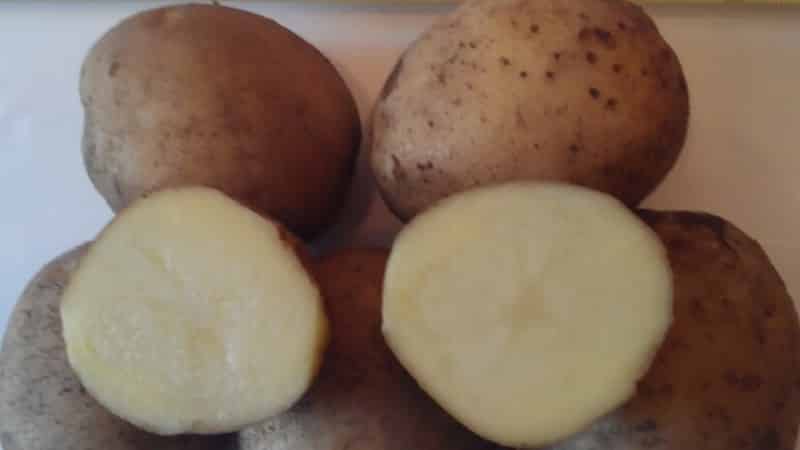
Differences from other varieties
The taste of potatoes is not watery, rich. It has an average yield and a high degree of disease resistance. Fertilization with mineral fertilizers leads to an increase in the number of tubers and an improvement in presentation.
Reference. Zorachka potatoes belong to the culinary type AB, so they are suitable for salads and cooking.
It is recommended to be consumed fresh, without leaving for long-term storage. With proper care, it is possible to obtain a two-level harvest – on the 45th and 55th day after emergence.
Chemical composition, trace elements and vitamins
100 g of early ripening potatoes contains:
- water – 78-87 g;
- starch – 12-14 g;
- sugar – 0.5-1.3 g;
- proteins – 0.7-1.6 g;
- potassium, manganese, magnesium, phosphorus and other macro- and microelements – 0.9-1.0 g;
- biotin, beta-carotene, vitamins C, PP, A, group B – 15-18 mg.
The starch level is 12-14%.
Other potato varieties:
What is good about the German potato variety “Zekura”
Characteristics of tubers and yield
The variety is characterized by oval shaped tubers with a smooth surface and small eyes located far apart from each other. The peel is yellow with dark spots. The pulp is light yellow, hard, and slightly digestible.
The weight of one potato is 90-120 g. From one bush you can collect 9-10 pieces. presentation. The harvest depends on climatic conditions, soil composition, regularity of watering and amounts to 350-700 centners per hectare.
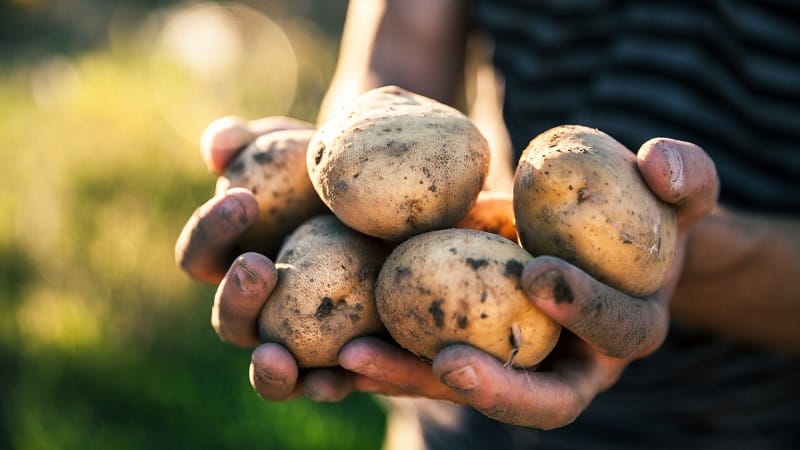
Region for cultivation and planting dates
After lengthy testing, the variety Zorachka is recommended for growing in Central and North-Western regions of Russia, as well as in Moldova, Ukraine and Belarus. Despite the fact that the variety is resistant to changes in temperature and air humidity, abundant watering is preferable for potatoes.
Lack of moisture and unsuitable soil affect the taste and size of tubers.
The main advantages and disadvantages of the variety
The positive qualities of the variety include:
- short ripening period - after 45 days the bushes are dug up and the first harvest is harvested;
- unpretentiousness to soil composition and weather conditions;
- high yields, allowing potatoes to be grown on a large industrial scale and on farms;
- ease of care;
- rich taste;
- due to its low starch content, the variety is resistant to transportation;
- excellent keeping quality;
- resistance to diseases and pests.
Among the shortcomings, gardeners note:
- susceptibility to Y virus;
- the need for frequent watering, and, as a result, loosening.
But, as practice shows, mulched potato beds evaporate less moisture and loosening is carried out less frequently.
Features of planting and growing
Potatoes are planted in May, when the soil warms up to a temperature of +7...+10°C. The soil is suitable: loamy, forest, peat, sandy loam. To improve the quality of the soil, sand, lime, and humus are added.
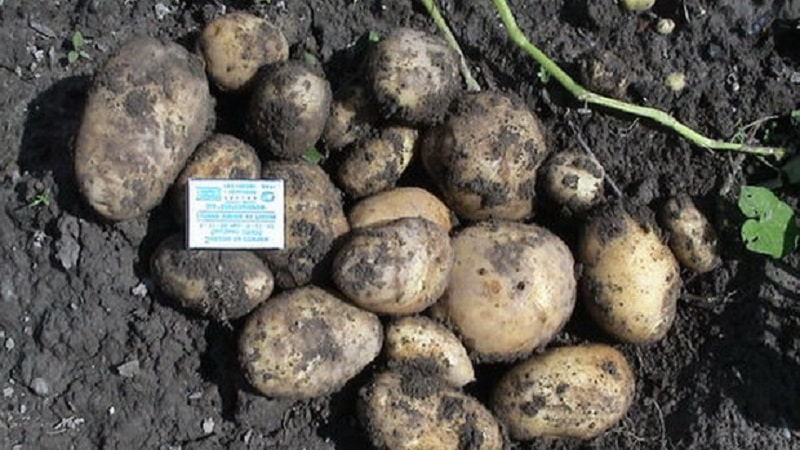
Preparing for landing
Tubers for planting are prepared in the fall, after harvesting.. To do this, thick, strong bushes are dug up, the tubers are dried for several days, avoiding direct sunlight. Select undamaged potatoes the size of a chicken egg and store them separately from the rest of the crop.
Two weeks before planting, the tubers are germinated, placing in a warm place and laying out in boxes in one layer. Sprinkle with sawdust, which is periodically sprayed with water - this way the potatoes germinate faster. Then it is covered with cloth or paper so that the sun's rays do not cause harm.
Important! When sprouts appear, they are treated with fungicides or sprayed with warm water and sprinkled with ash. This protects planting material from late blight.
Planting scheme and technology
The site is dug up, humus and compost are added. The holes are dug at a distance of 35-40 cm from each other, the gap between the rows is 55-60 cm. Large tubers are planted to a depth of 10 cm, smaller ones - to 7 cm.
During the planting process, the soil is additionally fertilized with a nutrient mixture., consisting of 150-200 g of peat, 1 tbsp. l. wood ash, 2 tsp. superphosphate. The collection is mixed with soil and a handful is placed in each planting hole.
Features of cultivation
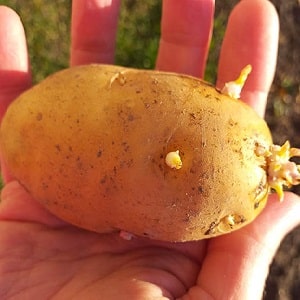 The main feature in the process of growing the variety is abundant watering with mandatory loosening of the soil. Otherwise, agricultural technology does not differ from that applicable to other types of potatoes.
The main feature in the process of growing the variety is abundant watering with mandatory loosening of the soil. Otherwise, agricultural technology does not differ from that applicable to other types of potatoes.
Choose an open, sunny place. Planted in May: in the northern regions - at the end of the month, in the southern regions - in the middle. Following the rules of crop rotation will help increase the yield - potatoes grow well after leafy vegetables, cabbage, carrots, and beets.
To achieve an even distribution of sunlight, the beds are arranged from north to south.
Important! During planting, it is not recommended to apply fresh manure; this can cause tuber diseases.
Nuances of care
It is better not to plant potatoes next to other plants of the nightshade family.: tomatoes, peppers, eggplants, which are subject to attacks by the Colorado potato beetle. The presence of pumpkins and cucumbers suffering from late blight in neighboring areas is also undesirable.
Exactly proper care of potatoes, including watering, loosening, hilling, and processing the bushes preserves the characteristic properties of the Zorachka variety and increases the mass of tubers by 20-25%.
Read also:
Watering mode
The first watering is carried out after green bushes appear on the surface height of at least 20 cm. The next watering is carried out during the budding period, when tubers are formed. After flowering ends, the bushes are not watered to avoid late blight.
The optimal amount of liquid for one plant is 3 l. The next day after watering, the soil around the bushes is loosened.
Top dressing
If a sufficient amount of complex fertilizer is added to the ground when planting potatoes, During the growth period you will need to fertilize the soil three times:
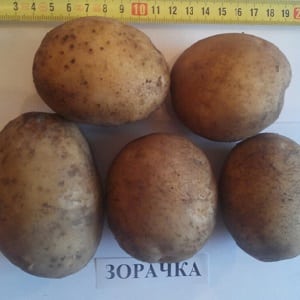 Two handfuls of humus for each bush before the first hilling.
Two handfuls of humus for each bush before the first hilling.- Dissolve 30 g of potassium sulfate in 10 liters of water, add the solution per 1 square meter. m of beds or 200 g of wood ash at the beginning of flowering.
- Apply an infusion of 10 liters of water, 50 g of superphosphate, 200 g of mullein under each bush in an amount of 500 ml during the flowering period.
At the beginning of growth, use organic nettle fertilizer.. To prepare it, fill a bucket 70% with grass, fill it with water, and leave to infuse for 14 days. Dilute the infusion with water in a ratio of 1:20 and water the crop.
Disease and pest control
The Zorachka variety is characterized by strong immunity to nematodes, cancer, relatively resistant to late blight of stems and fruits, but susceptible to Y-virus:
- Late blight appears at high humidity - about 90% - and an ambient temperature of +15-20°C. It appears as dark spots on the outside of the leaves and light spots on the back. Since it is useless to fight the disease, to prevent its spread to neighboring plants, diseased potato bushes are removed at the first signs of its manifestation.
- The Y virus can reduce crop yields by 70%. When signs appear in the form of yellow curled foliage, falling of the leaf blade, or the appearance of dark brown angular necrotic spots, the bushes are disposed of.
Harvest and storage
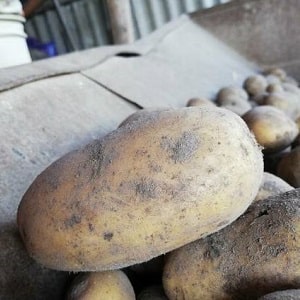 To obtain new potatoes collection begins 45 days after germination. Technically mature tubers are dug up after 70-75 days in warm sunny weather, having cleared a place on the site in advance.
To obtain new potatoes collection begins 45 days after germination. Technically mature tubers are dug up after 70-75 days in warm sunny weather, having cleared a place on the site in advance.
The dug up tubers are sorted, selecting damaged, rotten and deformed. The rest are treated with a solution of copper sulfate, lowered into a basement with a temperature of no more than +4°C and a humidity of 80-85% for further storage.
What difficulties may there be when growing
No particular difficulties have been identified in growing the Zorachka potato variety.. By choosing a place for planting where water does not accumulate, observing all the necessary conditions of agricultural technology, you get a good harvest of tasty, nutritious potatoes.
Advice from experienced gardeners and reviews about the Zorachka variety
Ogorodnikov The variety is suitable for its unpretentiousness in care, undemandingness to soil and climate.
Oksana, Ryazan: “Thanks to the early ripening period, we eat young potatoes in early July and store the remaining ones until the New Year. We have been growing it for five years. I did not notice any difficulties in growing. The main thing is to water, hill up on time and make sure that Colorado potato beetles do not attack.”.
Galina, Bryansk: “As a beginning gardener, I can’t help but note the ease of growing and resistance to disease, thanks to which we get a high yield of tasty, healthy potatoes that are suitable for use in home cooking.”.
Marina, Kaluga: “Every year, as an experiment, I plant a new variety of potatoes at the dacha. This year I tried the early variety Zorachka. The potatoes turned out to be tasty, both peeled and peeled. I especially liked it fried.”.
Conclusion
Considering the description and reviews of experienced farmers, it becomes clear that the Zorachka variety is an excellent early variety suitable for cultivation in many regions of Russia. It does not require special care, tolerates temperature changes well, and is resistant to pests and diseases. By following the standard rules of agricultural technology, you will get a high yield of tasty and healthy potatoes.